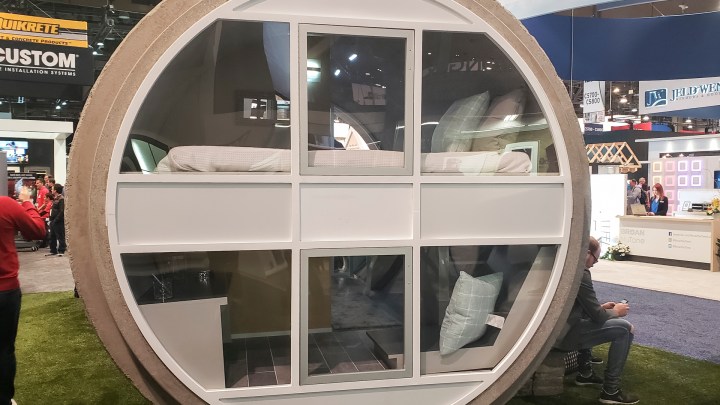
When Bolivia-born architectural student Sandra Guillen heard about a contest that involved creating a tiny home within a concrete pipe, she knew she would be the perfect person for the job.
After all, it was Guillen’s mom who used to tell her that if she didn’t study hard enough, living in a pipe is where she would end up.
“My mother would playfully threaten to send me to live in a pipe under the bridge if I didn’t do well in school,” Guillen said. “While I understood her point, it was also a harsh reminder of the homeless problem around the world. When I heard about the Pipe Dream contest, I knew it was my opportunity to make a difference.”
Guillen’s design stood out for its functionality, design, and how the outside was brought in.
So, the single mom of a 12-year-old entered the contest put on in partnership by Rinker Materials and the American Institute of Architecture Students (AIAS). The objective was to design the 16-feet-long, 8 feet in diameter concrete pipe into a low-cost, fully functional living space.
As you would imagine, the results are tight (100 square feet of living space), but homey and livable.
For example, Guillen included a covered porch and paver patio in the front with a built-in seat. Large French glass doors welcome visitors at the front, bringing the light in. Walk through the doors and there’s a tiny kitchen inside the tiny home, with a small sink and single-burner stove on the right, and drawers below. A small table sits to the left, big enough for two. Guillen used a teal color throughout the home, which pops against the gray of the concrete tube.
Take a couple of steps into the home, and there’s a shower/toilet room on the right, complete with white hexagonal tile. In the back of the unit, there’s a collapsible bed, couch, and workstation for a small bedroom and office combination. The back of the unit features wall-to-wall windows to bring extra light into the room.
Officials at Rinker and AIAS said that Guillen’s design stood out for its functionality, design, and how the outside was brought in, making it feel comfortable despite the small space.
The design can be assembled within the fire-resistant 30-ton pipe in less than a day and costs about $35,000.
“We are incredibly proud of Sandra — and all of our members who contributed to this competition — for their bold and innovative spirit,” said Charlie Klecha, interim executive director of the AIAS. “This competition and our partnership with Rinker Materials are valuable indicators of the kind of forward-thinking and actionable progress that can be achieved when we open our minds to the voices of a new generation.”
The contest was put on by Rinker and AIAS in an effort to show how making affordable housing can be a reality in an age where homelessness in the United States is a huge problem. The concrete pipe used for the contest is traditionally made for underground stormwater management, and tiny homes made from the pipe can be stacked if needed to solve housing problems just about everywhere. The concrete pipe tiny home is the first of its kind in the United States.
“Exploring our concrete pipe as a tool to fight homeless and overpopulation alongside the AIAS has already proven to be a viable prospect,” said Tom Hartley, vice president of sales and marketing for Rinker Materials. “Sandra’s unique perspective resulted in a smart, repeatable design that could truly make tiny concrete people homes accessible to anyone.”
The design can be assembled within the fire-resistant 30-ton pipe in less than a day and costs about $35,000, according to Rinker. A flatbed truck is required to transport the pipe to wherever it needs to go. Rinker officials say their long-term goal is to partner with the U.S. Department of Housing and Urban Development and the Federal Emergency Management Agency to bring the tiny concrete pipe homes to people in need, whether due to homelessness or displacement due to natural disasters.

Guillen said she found the project interesting and fun. She hopes that winning this contest shows her son what is possible.
“Concrete pipe makes the perfect structure for a tiny home, and hopefully my design will help many people live more comfortably,” Guillen said. “At the very least, this experience culminates my journey to earn a degree and sets a great example for my son.”




